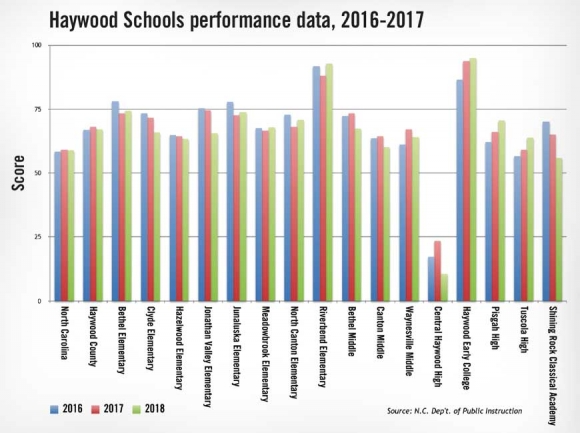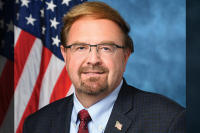Slight slip for Haywood Schools rank

Achieving high academic performance levels is one thing, but maintaining them is quite another, and after two straight years ranked 11 out of 115 public school districts in the state, recent reports from the N.C. Department of Public Instruction show that Haywood County schools slid three places to a still-impressive 14.
“First of all, no excuses,” said Dr. Bill Nolte, superintendent of Haywood County Schools since the retirement of Dr. Anne Garret last winter. “We’ve worked very hard to go from above average to really pretty good, and this is a year where we dropped nine-tenths of a point.”
The drop, from an even 68 down to 67.1, was good for a 1.32 percent decline, but still keeps the schools well ahead of the state’s 58.8 average.
“It’s never one thing, there’s a lot of moving parts,” Nolte said. “I attribute that in general to a significant year of transition. We lost a very effective superintendent at the end of February last year.”
Nolte took over as interim at that time, and was appointed to the full-time job earlier this summer.
“On top of that, we have about 600 students that change grade levels across schools, and that makes a difference,” he said. “Some classes are uniquely talented and do well without a lot of focus.”
Related Items
A number of Haywood’s elementary schools saw a drop in their ratings, including Clyde and Hazelwood, but especially Jonathan Valley.
“One of the things we focused on several years ago was technical text for elementary schools — not fiction text. And when we did that we got a really nice bump, because the real world is non-fiction. State assessments are non-fiction. Jobs are non-fiction and at least most of college, training for a new job is non-fiction,” he said. “I’m confident that we drifted away from that, and over time, our very good elementary schools drifted back to fiction. It’s interesting and captivating, but what the state wants is students who can function in the nonfiction world.”
Riverbend remains the jewel of Haywood’s elementary system, with 5 percent growth from last year’s 88.1 rating, climbing to 92.7 percent this year.
“Riverbend just stayed true to lots of non-fiction text,” Nolte said. “The other thing they do, and it also helps some other schools, is they do some early writing with children. Children can write at very early ages. We have a couple other schools, Bethel, that do that.”
Bethel elementary also improved slightly, by a point, but each of the county’s three middle schools showed significant decline of between 4 and 8 percent.
The good news is, the county’s three high schools all showed impressive growth — Pisgah jumped almost 7 percent to a 70.7 rating, and Tuscola climbed almost 8 percent to 63.8.
“I’m pretty proud of our high school work,” he said. “They’ve done a good job of going back to the standards they’re supposed to be teaching, and you won’t see a room where they’re not doing that — and it doesn’t matter what the subject is. I would say that 20 years ago, you could probably teach to the test. You knew the math formulas, you know how to teach students to go into a piece of literature, to find the answers, but over the last 10 years you can’t teach to the test, you have to think at a particularly high level.”
Although Haywood Early College only grew at 1.39 percent over last year, that growth puts the school in rarefied air — it’s now rated at above 95, and exact performance data is no longer scored above that level, so the actual improvement there could be much higher.
A decline of over 50 percent at Haywood’s alternative high school — from 23.6 to 10.5 — is concerning, but not as troubling as the numbers show, according to Nolte.
“Those are all students who are at significant risk of dropping out of school,” said Nolte. “Students do not go to Central Haywood High School because they are in trouble. Our alternative high school is not for that purpose. You go to there because you’ve gotten behind credits, and so by design it is a school for students who haven’t done well in school.”
By comparison, Haywood County’s only public charter school Shining Rock Classical Academy, continues a slide begun when the school first opened its doors in 2015.
That year, SRCA scored a 70 — slightly above the county’s 66.8 score that year. In 2017, it dropped to 65, below the county’s 68 rank. This year, with a 14 percent drop to a score of 56, SRCA is well below both the county score of 67.1 as well as the state’s 58 average.
For the full county reports, visit www.ncpublicschools.org/accountability/reporting.









